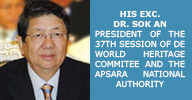Preface of His Excellency Dr Sok An
 |
|
| The sustainable protection of Angkor is the collective task and individualduty of all Cambodians. This is the meaning of the silhouette of Angkor Wat on our national flag (beyond the reference to the identity and the demonstration of our national pride).It also explains the constant solicitude that the prestigious site has been enjoying from the highest bodies of the State for the past two decades. The late King-Father, NORODOM Sihanouk, took, as early as in 1991, the initiative to propose the nomination of Angkor on the UNESCO World Heritage List. His successor, His Majesty NORODOM Sihamoni deigned, the day after his enthronement, to become the Honorary President of the International Co-ordinating Committee (ICC) for Angkor and is regularly briefed on the site works.The Royal Government, spearheaded by His Excellency the Prime Minister, Samdech Techo Hun Sen, has unwaveringly supported the conservation and sustainable development programmes in Angkor and its region, with a priority on Siem Reap.
As for the international community, a partner of the APSARA National Authority (managing the World Heritage site), it has continued to fully commit in the field and the developed projects have reached, as of today, the impressive number of 58 plus, concerning 15 countries. And this is far from being over. In Angkor the heritage is complex and to manage it brings together multiple approaches, techniques, state-of-the-art technologies and broad and varied skills. The area of the inscribed site is huge: 401Km2 (approximately |
ancient hydraulic system, a genuine landscape of living and rural activities, it is rich with intangible heritage and is a globalised tourism destination.The task is, however, complicated by the dual pressure exercised on the integrity of the Angkor site:a. One is endogenous, with the local population reaching more than 100,000 across 112 villages and hamlets scattered all over the site. These inhabitants continuously try to extend their living space, which may threaten the archaeological site. b. The other is exogenous and is related to the neighbouring city of Siem Reap, the provincial seat, where tourists sojourn and which creeping urban sprawl may extend towards the demarcated areas of the eco-historical site. We are aware of the challenges and so is the ICC co-chairmanship, valiantly carried out by France and Japan. In the well-augured forthcoming decade, all of us will ensure that the global situation of the protected zones remains satisfying, whilst according the necessary importance to tourism development pressure and guaranteeing at its best the sustainable management of the site. We do not forget that the key values that gained the inscription of Angkor on the World Heritage List are mainly based on the authenticity of the monuments and the integrity of the site. Our common endeavour aims at preserving this authenticity and safeguarding this integrity. |
